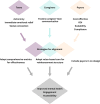Payors, Caregivers, and Teens: Aligning Priorities for Effective Digital Mental Health Tools
- PMID: 40811700
- PMCID: PMC12352698
- DOI: 10.2196/72587
Payors, Caregivers, and Teens: Aligning Priorities for Effective Digital Mental Health Tools
Abstract
Digital mental health (DMH) tools are a promising solution to the growing need for mental health care among teens because of their scalability and accessibility. Yet the key stakeholders-payors (who reimburse), caregivers (who facilitate adoption and access), and teens aged 13-17 (the primary users of these tools)-often have conflicting priorities. These misaligned priorities can limit investment in tools that align with user needs and promote long-term engagement, ultimately hindering the effective deployment of DMH tools for teens. This viewpoint paper outlines payor, caregiver, and teen priorities for DMH tools and proposes novel strategies to align these priorities. We argue that this alignment is critical for driving meaningful improvements in teen well-being.
Keywords: adolescents; caregivers; digital mental health interventions; mental health; parents; payors; teens.
© Jennifer Huberty, Jacqlyn Yourell, Lara Baez, Louisa Salhi. Originally published in the Journal of Medical Internet Research (https://www.jmir.org).
Conflict of interest statement
Figures
Similar articles
-
Teen Perspectives on Integrating Digital Mental Health Programs for Teens Into Public Libraries ("I Was Always at the Library"): Qualitative Interview Study.JMIR Form Res. 2025 Mar 13;9:e67454. doi: 10.2196/67454. JMIR Form Res. 2025. PMID: 40080819 Free PMC article.
-
Digital Mental Health Screening, Feedback, and Referral System for Teens With Socially Complex Needs: Protocol for a Randomized Controlled Trial Integrating the Teen Assess, Check, and Heal System into Pediatric Primary Care.JMIR Res Protoc. 2025 Feb 18;14:e65245. doi: 10.2196/65245. JMIR Res Protoc. 2025. PMID: 39965196 Free PMC article.
-
How lived experiences of illness trajectories, burdens of treatment, and social inequalities shape service user and caregiver participation in health and social care: a theory-informed qualitative evidence synthesis.Health Soc Care Deliv Res. 2025 Jun;13(24):1-120. doi: 10.3310/HGTQ8159. Health Soc Care Deliv Res. 2025. PMID: 40548558
-
Identifying and Addressing Bullying.2023 Dec 13. In: StatPearls [Internet]. Treasure Island (FL): StatPearls Publishing; 2025 Jan–. 2023 Dec 13. In: StatPearls [Internet]. Treasure Island (FL): StatPearls Publishing; 2025 Jan–. PMID: 28722959 Free Books & Documents.
-
Digital interventions in mental health: evidence syntheses and economic modelling.Health Technol Assess. 2022 Jan;26(1):1-182. doi: 10.3310/RCTI6942. Health Technol Assess. 2022. PMID: 35048909 Free PMC article.
References
-
- Rideout V, Fox S, Peebles A, Robb MB. Common Sense Media; 2021. Coping with COVID‑19: how young people use digital media to manage their mental health.
-
- Children and youth. Medicaid. [10-06-2025]. https://www.medicaid.gov/medicaid/benefits/behavioral-health-services/ch... URL. Accessed.
-
- Mental health. InsureKidsNow.gov. [10-06-2025]. https://www.insurekidsnow.gov/initiatives/mental-health URL. Accessed.
LinkOut - more resources
Full Text Sources


